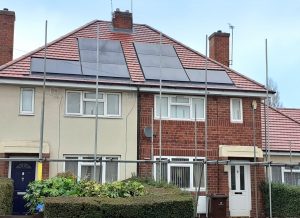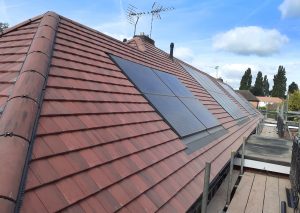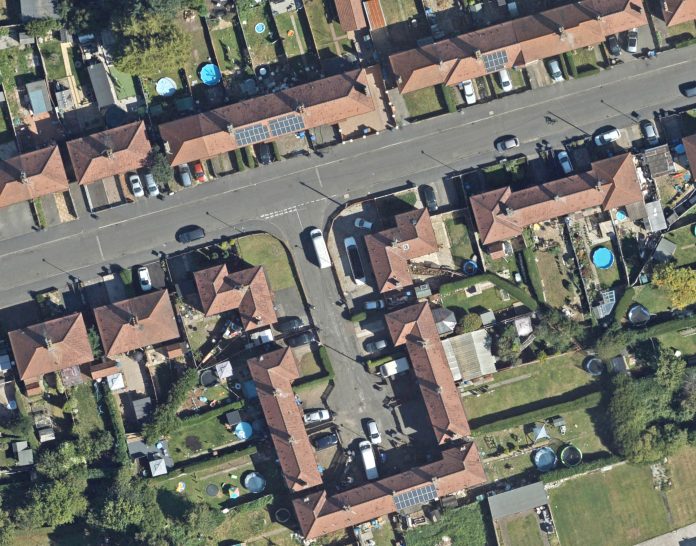Aerial mapping reveals the potential of roof spaces to mitigate the effects of climate change
Leicestershire-based aerial mapping company Bluesky International is working with public and private sector organisations across the UK to discover how they use urban roof spaces to tackle contributing behaviours to and impacts of climate change.
- Location: Derby, UK
- Sector: Housing
- Completion: Ongoing
One recent example is the work it has carried out with Derby Homes, an Arm’s Length Management Organisation (ALMO) and wholly owned subsidiary of Derby City Council. Created in 2002 to manage and maintain the council’s housing stock, Derby Homes’ core business is the management of, and investment in, Derby’s social housing stock, comprising of circa 12,600 properties.
Since 2016, Derby Homes has installed around 1,000 solar panels to the roofs of council homes. The original programme used a pre-procured framework and in-house training to fit as many solar systems as possible in the shortest space of time. Initially targeting suitable bungalows then blocks of flats with large roofs, the aim was to help as many tenants as possible with their fuel bills.
“We had already completed a successful programme of solar installations targeting suitable properties where we could fit large systems. These installations save 1,000 tonnes of carbon, generate 1.9 gigawatt hours of electricity per year and save householders on average £150 a year on fuel bills,” said Ashley Redfern, senior maintenance surveyor, Derby Homes.
“However, following Derby City Council’s climate emergency announcement and the impact of rising energy prices on our residents, we knew we needed to do more.”
In order to increase the rollout of solar panels across its housing stock, Derby Homes turned to Bluesky. Derby Homes provided Bluesky with a master list of 8,200 addresses to consider alongside a specification that considered roof pitch and aspect, and available roof space.
Using the most up-to-date aerial photography – ultra-high 5cm resolution cover flown in 2020 – together with photogrammetrically derived 3D height models (Digital Terrain and Digital Surface Models DTM/DSM) and supplementary LiDAR (Light Detection and Ranging) data, Bluesky created automated algorithms to extract all roofs that met the pitch – 0-45 degrees, and aspect – 110-270 degrees, parameters set by Derby Homes.
These roofs were then measured to see how many 170cm x 90cm panels could be accommodated, taking into account any existing roof furniture that was already occupying space, such as Velux or dormer windows and chimneys. Bluesky also considered the effect of overhanging vegetation that may impact on a panel’s ability to capture solar energy for at least six months of the year when in full leaf.
A cost-effective approach
Using the Bluesky derived intelligence, Derby Homes is now starting to integrate the installation of solar PV panels with the renewal of existing roofs. This is a cost-effective approach as it uses the roofer to install the integrated tiles and scaffolding that is already up. Derby Homes also plans to use Bluesky’s data to ascertain if properties can accommodate different types of top-fitted systems, such as flat roofs, and forecast numbers and costings for future planning and budgets.
“Working with Bluesky, we initially defined the study for a 3kW top fitted system, but this did not return as many results as we hoped, so we reduced our threshold to a 2.4kW integrated system and as a result, we have already fitted a number of systems and hope to make our case to fit over 2,000 more integrated solar PV systems.”
Bluesky is the only company in the UK to have complete, high resolution, aerial photographic coverage for the whole of the England, Scotland, Wales and the Republic of Ireland. Since completing its first solar potential aerial mapping project back in 2010, Bluesky has gone on to assess the suitability for solar power generation of millions of properties working with organisations such as Sustain (now part of the Anthesis global sustainability group), construction company Kier, in partnership with Harlow Council and Loughborough University.
In addition to exploring the potential of roofs for the generation of renewable energy, Bluesky data has also been used to map green infrastructure and identify the potential to increase biodiversity in cities across the UK.
Using 12.5cm resolution imagery, technology start-up Gentian has developed an advanced workflow based on machine learning algorithms, which automatically identifies and records the number of buildings with green roofs. Gentian is helping local authorities explore the capacity of new developments and enhance the value of existing properties in a bid to mitigate the loss of biodiversity and the negative impacts of climate change, reduce flooding and improve air quality.
‘An essential tool in the war against climate change’
“Green infrastructure is an essential tool in the war against climate change, reduced biodiversity and the health impacts of air pollution and rising temperatures in our cities,” commented Thomas Fenal, co-founder and chief technical officer of Gentian.
“In terms of green roofs, other benefits include building insulation, rainfall absorption and, if accessible or visible, boosts for wellbeing and even property prices.
“However, unlike other types of green infrastructure, such as parks and open spaces, the use of roof space has been somewhat ad hoc. Using the Bluesky photography, we now have a highly detailed and highly accurate view of this underutilised resource. We can benchmark where a city currently is, both in terms of extent and quality of green roofs, and we can identify potential properties for retrofit projects.”
Ralph Coleman, sales director at Bluesky International, concluded: “In terms of managing the global challenges facing society, such as climate change, extreme weather events, biodiversity loss and livelihood crises, geospatial intelligence has a crucial role. Only by understanding the environments in which we live and work and being able to model, measure and analyse these issues and our response to them, can we hope to meaningfully address them.”
Ralph Coleman
Sales director
Tel: +44 (0)1530 518 518














